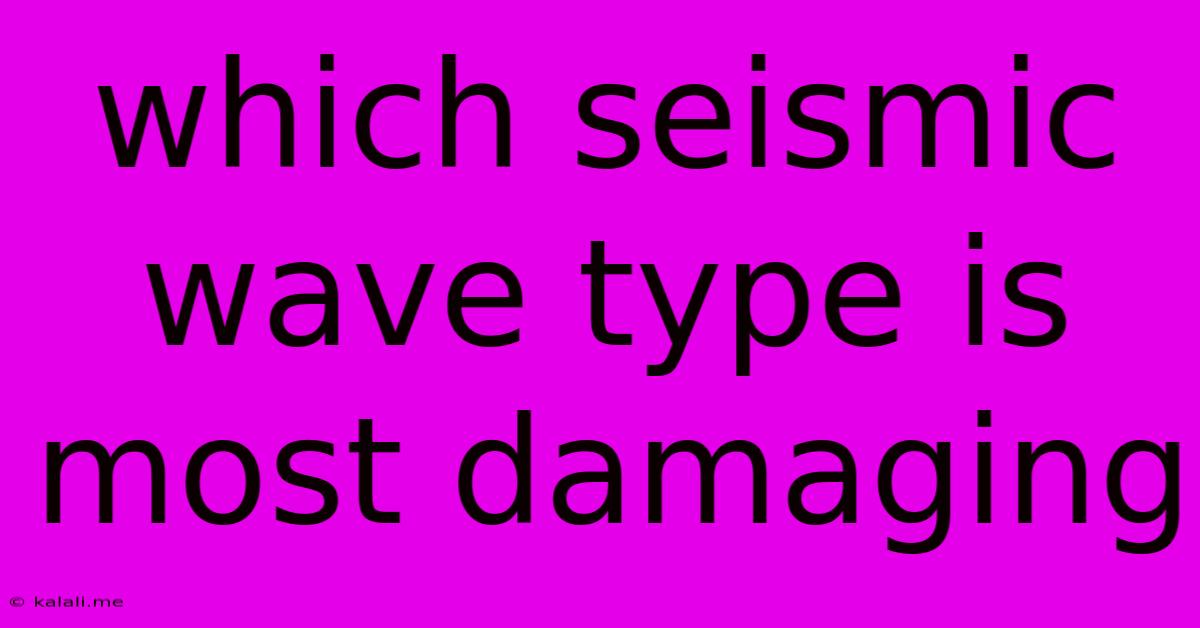Which Seismic Wave Type Is Most Damaging
Kalali
Jun 14, 2025 · 3 min read

Table of Contents
Which Seismic Wave Type is Most Damaging? Understanding Earthquake Waves and Their Impact
Earthquakes, terrifying natural events, unleash a cascade of seismic waves that propagate through the Earth's crust. Understanding the different types of these waves and their destructive potential is crucial for mitigating earthquake risks and building safer infrastructure. This article delves into the various seismic waves, highlighting which type is most responsible for the devastating effects we see during an earthquake.
Understanding Seismic Waves: A Quick Overview
Seismic waves are essentially vibrations that travel through the Earth. They are generated by the sudden release of energy along fault lines, causing the ground to shake violently. There are two main categories of seismic waves: body waves and surface waves.
-
Body Waves: These waves travel through the Earth's interior. There are two types:
- P-waves (Primary waves): These are compressional waves, meaning they move particles back and forth in the same direction as the wave's propagation. They are the fastest seismic waves and thus the first to arrive at a seismograph. While they cause some ground shaking, their impact is relatively less destructive compared to other wave types.
- S-waves (Secondary waves): These are shear waves, moving particles perpendicular to the wave's direction. They are slower than P-waves and arrive after them. S-waves cause more ground shaking than P-waves, but still less damage than surface waves.
-
Surface Waves: These waves travel along the Earth's surface. They are slower than body waves but are responsible for the most significant damage during an earthquake. There are two primary types:
- Love waves: These waves move the ground horizontally, perpendicular to the direction of propagation. Their motion resembles a snake slithering, causing significant ground displacement and damage to structures.
- Rayleigh waves: These waves move the ground in an elliptical motion, similar to ocean waves. They are generally the slowest surface waves but can cause significant ground rolling and are responsible for a substantial amount of damage.
The Most Damaging Seismic Wave: Surface Waves Take the Lead
While P-waves and S-waves contribute to the overall shaking, surface waves (Love and Rayleigh waves) are undoubtedly the most damaging type of seismic wave. Their longer duration and larger amplitude of motion cause more significant ground displacement and structural damage than body waves.
Here's why surface waves cause the most damage:
- Larger Amplitude: Surface waves have a much larger amplitude than body waves, meaning they cause a greater degree of ground shaking. This increased shaking exerts greater forces on structures, leading to more severe damage.
- Longer Duration: Surface waves travel along the surface and persist for a longer duration than body waves, which dissipate energy as they travel deeper into the earth. This prolonged shaking further amplifies the destructive impact on buildings and infrastructure.
- Complex Ground Motion: The complex, rolling motion of Rayleigh waves and the horizontal shearing of Love waves can cause significant damage to foundations, leading to collapse and severe structural failure.
Factors Influencing Damage:
The extent of damage caused by seismic waves is not solely determined by the wave type. Several other factors play a crucial role:
- Magnitude of the Earthquake: Larger earthquakes generate stronger waves with greater amplitude and duration, resulting in more extensive damage.
- Distance from the Epicenter: The intensity of shaking diminishes with distance from the earthquake's epicenter.
- Local Soil Conditions: The type of soil or rock underlying a region significantly influences how seismic waves propagate and amplify. Soft soils can amplify the shaking, increasing the potential for damage.
- Building Design and Construction: Buildings designed and constructed with earthquake-resistant features can withstand seismic shaking far better than those lacking such features.
Conclusion:
While all seismic waves contribute to the overall effects of an earthquake, surface waves – particularly Love and Rayleigh waves – are consistently identified as the primary cause of significant damage during seismic events. Understanding this crucial distinction is vital for improving earthquake preparedness, building more resilient structures, and mitigating the devastating impact of these powerful natural forces. Ongoing research into seismic wave propagation and their interaction with different geological formations is essential for enhancing our understanding of earthquake hazards and developing effective mitigation strategies.
Latest Posts
Latest Posts
-
Which Of The Following Statements About Minerals Is False
Jun 14, 2025
-
Put The Following Events In Chronological Order
Jun 14, 2025
-
What Is The Least Common Multiple Of 120 And 80
Jun 14, 2025
-
An Autotransformer Is One Of The Methods Used To
Jun 14, 2025
-
Software That Manages The Resources Of The Computer Is Called
Jun 14, 2025
Related Post
Thank you for visiting our website which covers about Which Seismic Wave Type Is Most Damaging . We hope the information provided has been useful to you. Feel free to contact us if you have any questions or need further assistance. See you next time and don't miss to bookmark.